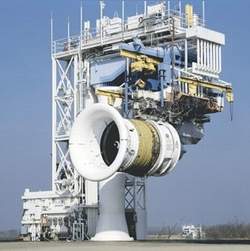First Entered Service In 1995
Since entering service in 1995, GE’s GE90 engine family has reached 40 million flight hours, with more than 1,725 GE90 engines flying with 63 operators.

“The GE90 engine is quickly accumulating flight hours as we deliver record number of GE90-powered Boeing 777 aircraft to our customers,” said Bill Millhaem, general manager of the GE90/GE9X program. “The engine achieved 20 million flights hours in 2010, but doubled that number in just four years while retaining its 99.98% reliability rate.”
Production levels for the GE90 engine rose from 180 engines in 2012 to 220 engines in 2013, with 230 engines scheduled for delivery in 2014. The engine backlog has grown to more than 600 engines.
With 115,000 pounds of thrust, the GE90-115B engine entered service nearly a decade ago with arguably the toughest demands on a high-thrust commercial jet engine. The extraordinary mission range of the twin-engine 777-300ER and 777-200LR with its record-breaking nonstop flights required the engine to provide record thrust levels, which, in turn, demanded the industry’s highest engine core temperatures and overall pressure ratios.
The engine has met the demands with great fuel efficiency and reliability (GE90-115B-powered 777s pioneered 330-minute ETOPS) while operating in tough environments, such as the Middle East where large, twin-engine airliners had limited experience before the Boeing 777 family. The engine has achieved the best fuel burn on Boeing 777s, which is actually 3.6% better than what GE committed during development.
The GE90-115B engine has a dispatch reliability rate of 99.98% and an engine-caused, in-flight shutdown rate of 0.001. This means an airline pilot will likely operate a GE90-115B-powered Boeing 777 for an entire career without experiencing an engine-caused shutdown in flight.
Over the past decade, GE has invested about $50 million annually on GE90-115B component improvements, from the front composite fan blades to the lower-pressure turbine blades in the back of the engine. Many of these advancements are being incorporated into the new GE9X design. That was always the plan.

“Hundreds of GE90-115B design practices will continue to be modified based on experience to inform the GE9X design,” said Millhaem, general manager of the GE90/GE9X program. “These practices include combustion, fan blades, turbine loading, how air is delivered to the turbine, managing the clearance control system, and achieving performance retention and durability. Today, we are now looking at novel new design approaches to eliminate the impact of dust accumulation in hot section engines to further improve engine durability. The GE90-115B has been one of GE’s great technical achievements, and gives us great confidence and enthusiasm for the GE9X program. ”
The GE9X development roadmap mirrors GE90 design and development practices, including GE’s “core value” strategy of continually running, evaluating, and iterating upon engine hot-section cores (compressor/combustor/high pressure turbine) over several years in order to achieve the maximum efficiency and durability in the engine’s final design.
The GE9X engine will be in the 100,000 lbs. thrust class. Key features include a 133” diameter composite fan case and 16 composite fan blades; next-generation 27:1 pressure ratio 11-stage high pressure compressor; a 3rd-generation TAPS (twin annular pre-swirl) combustor for greater efficiency and low emissions; and ceramic matrix composite (CMC) material in the combustor and turbine. The GE9X compressor ratio of 27-to-1 will exceed the GE90-115B, coupled with a larger, higher-flow fan. This combination – which will be unique to jet propulsion – will be the centerpiece of GE’s most fuel efficient jet engine ever with a 10 percent improvement in fuel burn over the GE90-115B.
The order book for the GE9X is growing rapidly. Since launching on the Boeing 777X last year, 600 GE9X engines were ordered by six operators. Technology maturation testing for the GE9X engine continues this year, with GE investing $300 million on key component testing. The first full core test is scheduled for 2015. The first engine will test in 2016 with flight testing on GE’s flying testbed anticipated in 2017. Engine certification is scheduled for 2018.
(Image provided by GE)
 ANN's Daily Aero-Linx (04.15.24)
ANN's Daily Aero-Linx (04.15.24) Classic Aero-TV: 'No Other Options' -- The Israeli Air Force's Danny Shapira
Classic Aero-TV: 'No Other Options' -- The Israeli Air Force's Danny Shapira Aero-News: Quote of the Day (04.15.24)
Aero-News: Quote of the Day (04.15.24) Airborne 04.16.24: RV Update, Affordable Flying Expo, Diamond Lil
Airborne 04.16.24: RV Update, Affordable Flying Expo, Diamond Lil ANN's Daily Aero-Term (04.16.24): Chart Supplement US
ANN's Daily Aero-Term (04.16.24): Chart Supplement US




